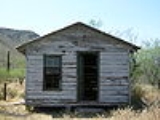
Bates Well Ranch
Encyclopedia
The Bates Well Ranch also known as the Bates Well, Growler Well, Gray Ranch and El Veit, was one of the fifteen ranches and line camps in the Gray family cattle business in the Sonoran Desert
country north of the US-Mexico border in Pima County
, Arizona
. Operating for nearly 60 years, the ranch is now part of Organ Pipe Cactus National Monument
.
The main ranch house was moved from Growler Mine to Bates Well in 1942, re-used in traditional frontier and Gray family practice. Probably originating as a miners' cabin, the northern portion was presumably added after its relocation at Bates Well. The original well may have been dug by W.B. Bates about 1870, with a later well dug by Reuben Daniels circa 1913. An arrastra
, a simple ore-milling operation, existed in the early 20th century. The property was developed by Robert Louis Gray's son, Henry from 1935 on. Henry lived there until his death in 1976.
The Bates Well property represents a very complete and intact example of the frontier ranching pattern in Arizona typical of the Sonoran Desert during the first third of the twentieth century. The Gray family controlled essentially all ranching operations in the Organ Pipe National Monument area, including Aguajita Spring, Alamo Canyon Ranch, Bonita Well Line Camp, Bull Pasture, Cement Tank, Dos Lomitas Ranch
, Dowling Ranch, Gachado Line Camp, Hocker Well, Pozo Nuevo Line Camp, Pozo Salado or Salt Well, Red Tanks Well, Wild Horse Tank and Williams Spring. Ranching operations ceased in 1976.
Sonoran Desert
The Sonoran Desert is a North American desert which straddles part of the United States-Mexico border and covers large parts of the U.S. states of Arizona and California and the northwest Mexican states of Sonora, Baja California, and Baja California Sur. It is one of the largest and hottest...
country north of the US-Mexico border in Pima County
Pima County, Arizona
-2010:Whereas according to the 2010 U.S. Census Bureau:*74.3% White*3.5% Black*3.3% Native American*2.6% Asian*0.2% Native Hawaiian or Pacific Islander*3.7% Two or more races*12.4% Other races*34.6% Hispanic or Latino -2000:...
, Arizona
Arizona
Arizona ; is a state located in the southwestern region of the United States. It is also part of the western United States and the mountain west. The capital and largest city is Phoenix...
. Operating for nearly 60 years, the ranch is now part of Organ Pipe Cactus National Monument
Organ Pipe Cactus National Monument
Organ Pipe Cactus National Monument is a U.S. National Monument and UNESCO biosphere reserve located in extreme southern Arizona which shares a border with the Mexican state of Sonora. The park is the only place in the United States where the Organ Pipe Cactus grows wild...
.
The main ranch house was moved from Growler Mine to Bates Well in 1942, re-used in traditional frontier and Gray family practice. Probably originating as a miners' cabin, the northern portion was presumably added after its relocation at Bates Well. The original well may have been dug by W.B. Bates about 1870, with a later well dug by Reuben Daniels circa 1913. An arrastra
Arrastra
An Arrastra is a primitive mill for grinding and pulverizing gold or silver ore. The simplest form of the arrastra is two or more flat-bottomed drag stones placed in a circular pit paved with flat stones, and connected to a center post by a long arm...
, a simple ore-milling operation, existed in the early 20th century. The property was developed by Robert Louis Gray's son, Henry from 1935 on. Henry lived there until his death in 1976.
The Bates Well property represents a very complete and intact example of the frontier ranching pattern in Arizona typical of the Sonoran Desert during the first third of the twentieth century. The Gray family controlled essentially all ranching operations in the Organ Pipe National Monument area, including Aguajita Spring, Alamo Canyon Ranch, Bonita Well Line Camp, Bull Pasture, Cement Tank, Dos Lomitas Ranch
Dos Lomitas Ranch
The Dos Lomitas Ranch, also known as the Rattlesnake Ranch, Blankenship Well and the Gray Ranch, was the first of fifteen ranches and line camps in the Gray family cattle business in the Sonoran Desert country north of the US-Mexico border in Arizona. The ranch is now part of Organ Pipe Cactus...
, Dowling Ranch, Gachado Line Camp, Hocker Well, Pozo Nuevo Line Camp, Pozo Salado or Salt Well, Red Tanks Well, Wild Horse Tank and Williams Spring. Ranching operations ceased in 1976.
External links
- Bates Well, Cowhand House, Growler Wash, Ajo vicinity, Pima County, AZ: 2 photos, 1 data page, 1 photo caption page, at Historic American Building Survey
- Bates Well, Corral, Growler Wash, Ajo vicinity, Pima County, AZ: 1 photo, 1 data page, 1 photo caption page, at Historic American Building Survey
- Bates Well, Jacal, Growler Wash, Ajo vicinity, Pima County, AZ: 1 photo, 1 data page, 1 photo caption page, at Historic American Building Survey

